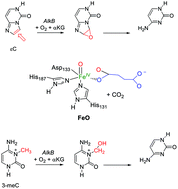当前位置:
X-MOL 学术
›
Dalton Trans.
›
论文详情
Our official English website, www.x-mol.net, welcomes your feedback! (Note: you will need to create a separate account there.)
Computational studies of DNA base repair mechanisms by nonheme iron dioxygenases: selective epoxidation and hydroxylation pathways
Dalton Transactions ( IF 4 ) Pub Date : 2020/02/25 , DOI: 10.1039/d0dt00007h Reza Latifi 1, 2, 3, 4 , Jennifer L. Minnick 1, 2, 3, 4 , Matthew G. Quesne 5, 6, 7, 8, 9 , Sam P. de Visser 8, 10, 11 , Laleh Tahsini 1, 2, 3, 4
Dalton Transactions ( IF 4 ) Pub Date : 2020/02/25 , DOI: 10.1039/d0dt00007h Reza Latifi 1, 2, 3, 4 , Jennifer L. Minnick 1, 2, 3, 4 , Matthew G. Quesne 5, 6, 7, 8, 9 , Sam P. de Visser 8, 10, 11 , Laleh Tahsini 1, 2, 3, 4
Affiliation

|
DNA base repair mechanisms of alkylated DNA bases is an important reaction in chemical biology and particularly in the human body. It is typically catalyzed by an α-ketoglutarate-dependent nonheme iron dioxygenase named the AlkB repair enzyme. In this work we report a detailed computational study into the structure and reactivity of AlkB repair enzymes with alkylated DNA bases. In particular, we investigate the aliphatic hydroxylation and C![[double bond, length as m-dash]](https://www.rsc.org/images/entities/char_e001.gif) C epoxidation mechanisms of alkylated DNA bases by a high-valent iron(IV)–oxo intermediate. Our computational studies use quantum mechanics/molecular mechanics methods on full enzymatic structures as well as cluster models on active site systems. The work shows that the iron(IV)–oxo species is rapidly formed after dioxygen binding to an iron(II) center and passes a bicyclic ring structure as intermediate. Subsequent cluster models explore the mechanism of substrate hydroxylation and epoxidation of alkylated DNA bases. The work shows low energy barriers for substrate activation and consequently energetically feasible pathways are predicted. Overall, the work shows that a high-valent iron(IV)–oxo species can efficiently dealkylate alkylated DNA bases and return them into their original form.
C epoxidation mechanisms of alkylated DNA bases by a high-valent iron(IV)–oxo intermediate. Our computational studies use quantum mechanics/molecular mechanics methods on full enzymatic structures as well as cluster models on active site systems. The work shows that the iron(IV)–oxo species is rapidly formed after dioxygen binding to an iron(II) center and passes a bicyclic ring structure as intermediate. Subsequent cluster models explore the mechanism of substrate hydroxylation and epoxidation of alkylated DNA bases. The work shows low energy barriers for substrate activation and consequently energetically feasible pathways are predicted. Overall, the work shows that a high-valent iron(IV)–oxo species can efficiently dealkylate alkylated DNA bases and return them into their original form.
中文翻译:

非血红素铁双加氧酶对DNA碱基修复机制的计算研究:选择性环氧化和羟化途径
烷基化DNA碱基的DNA碱基修复机制是化学生物学尤其是人体中的重要反应。它通常由称为AlkB修复酶的α-酮戊二酸依赖性非血红素铁双加氧酶催化。在这项工作中,我们报告了对AlkB修复酶与烷基化DNA碱基的结构和反应性的详细计算研究。特别是,我们研究了![[双键,长度为m-破折号]](https://www.rsc.org/images/entities/char_e001.gif) 由高价铁(IV)-氧代中间体形成的烷基化DNA碱基的脂肪族羟基化和C C环氧化机理。我们的计算研究在完整的酶促结构上使用量子力学/分子力学方法,并在活动位点系统上使用簇模型。工作表明,铁(四)–氧原子在双氧结合到铁(II)中心后迅速形成,并以双环结构为中间体。随后的群集模型探讨了底物羟基化和烷基化DNA碱基环氧化的机制。这项工作表明底物活化的能量屏障很低,因此可以预测出在能量上可行的途径。总体而言,这项工作表明,高价铁(IV)-氧代物种可以有效地使烷基化的DNA碱基脱烷基化,并使它们恢复其原始形式。
由高价铁(IV)-氧代中间体形成的烷基化DNA碱基的脂肪族羟基化和C C环氧化机理。我们的计算研究在完整的酶促结构上使用量子力学/分子力学方法,并在活动位点系统上使用簇模型。工作表明,铁(四)–氧原子在双氧结合到铁(II)中心后迅速形成,并以双环结构为中间体。随后的群集模型探讨了底物羟基化和烷基化DNA碱基环氧化的机制。这项工作表明底物活化的能量屏障很低,因此可以预测出在能量上可行的途径。总体而言,这项工作表明,高价铁(IV)-氧代物种可以有效地使烷基化的DNA碱基脱烷基化,并使它们恢复其原始形式。
更新日期:2020-04-08
![[double bond, length as m-dash]](https://www.rsc.org/images/entities/char_e001.gif) C epoxidation mechanisms of alkylated DNA bases by a high-valent iron(IV)–oxo intermediate. Our computational studies use quantum mechanics/molecular mechanics methods on full enzymatic structures as well as cluster models on active site systems. The work shows that the iron(IV)–oxo species is rapidly formed after dioxygen binding to an iron(II) center and passes a bicyclic ring structure as intermediate. Subsequent cluster models explore the mechanism of substrate hydroxylation and epoxidation of alkylated DNA bases. The work shows low energy barriers for substrate activation and consequently energetically feasible pathways are predicted. Overall, the work shows that a high-valent iron(IV)–oxo species can efficiently dealkylate alkylated DNA bases and return them into their original form.
C epoxidation mechanisms of alkylated DNA bases by a high-valent iron(IV)–oxo intermediate. Our computational studies use quantum mechanics/molecular mechanics methods on full enzymatic structures as well as cluster models on active site systems. The work shows that the iron(IV)–oxo species is rapidly formed after dioxygen binding to an iron(II) center and passes a bicyclic ring structure as intermediate. Subsequent cluster models explore the mechanism of substrate hydroxylation and epoxidation of alkylated DNA bases. The work shows low energy barriers for substrate activation and consequently energetically feasible pathways are predicted. Overall, the work shows that a high-valent iron(IV)–oxo species can efficiently dealkylate alkylated DNA bases and return them into their original form.
中文翻译:

非血红素铁双加氧酶对DNA碱基修复机制的计算研究:选择性环氧化和羟化途径
烷基化DNA碱基的DNA碱基修复机制是化学生物学尤其是人体中的重要反应。它通常由称为AlkB修复酶的α-酮戊二酸依赖性非血红素铁双加氧酶催化。在这项工作中,我们报告了对AlkB修复酶与烷基化DNA碱基的结构和反应性的详细计算研究。特别是,我们研究了
![[双键,长度为m-破折号]](https://www.rsc.org/images/entities/char_e001.gif) 由高价铁(IV)-氧代中间体形成的烷基化DNA碱基的脂肪族羟基化和C C环氧化机理。我们的计算研究在完整的酶促结构上使用量子力学/分子力学方法,并在活动位点系统上使用簇模型。工作表明,铁(四)–氧原子在双氧结合到铁(II)中心后迅速形成,并以双环结构为中间体。随后的群集模型探讨了底物羟基化和烷基化DNA碱基环氧化的机制。这项工作表明底物活化的能量屏障很低,因此可以预测出在能量上可行的途径。总体而言,这项工作表明,高价铁(IV)-氧代物种可以有效地使烷基化的DNA碱基脱烷基化,并使它们恢复其原始形式。
由高价铁(IV)-氧代中间体形成的烷基化DNA碱基的脂肪族羟基化和C C环氧化机理。我们的计算研究在完整的酶促结构上使用量子力学/分子力学方法,并在活动位点系统上使用簇模型。工作表明,铁(四)–氧原子在双氧结合到铁(II)中心后迅速形成,并以双环结构为中间体。随后的群集模型探讨了底物羟基化和烷基化DNA碱基环氧化的机制。这项工作表明底物活化的能量屏障很低,因此可以预测出在能量上可行的途径。总体而言,这项工作表明,高价铁(IV)-氧代物种可以有效地使烷基化的DNA碱基脱烷基化,并使它们恢复其原始形式。


























 京公网安备 11010802027423号
京公网安备 11010802027423号